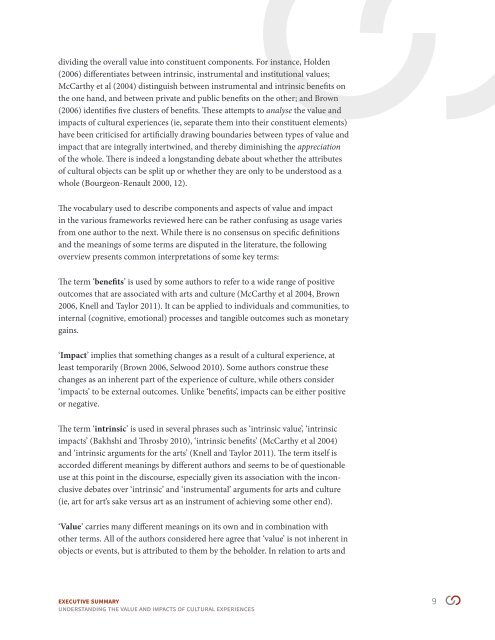aceUVi
aceUVi
aceUVi
Create successful ePaper yourself
Turn your PDF publications into a flip-book with our unique Google optimized e-Paper software.
dividing the overall value into constituent components. For instance, Holden<br />
(2006) differentiates between intrinsic, instrumental and institutional values;<br />
McCarthy et al (2004) distinguish between instrumental and intrinsic benefits on<br />
the one hand, and between private and public benefits on the other; and Brown<br />
(2006) identifies five clusters of benefits. These attempts to analyse the value and<br />
impacts of cultural experiences (ie, separate them into their constituent elements)<br />
have been criticised for artificially drawing boundaries between types of value and<br />
impact that are integrally intertwined, and thereby diminishing the appreciation<br />
of the whole. There is indeed a longstanding debate about whether the attributes<br />
of cultural objects can be split up or whether they are only to be understood as a<br />
whole (Bourgeon-Renault 2000, 12).<br />
The vocabulary used to describe components and aspects of value and impact<br />
in the various frameworks reviewed here can be rather confusing as usage varies<br />
from one author to the next. While there is no consensus on specific definitions<br />
and the meanings of some terms are disputed in the literature, the following<br />
overview presents common interpretations of some key terms:<br />
The term ‘benefits’ is used by some authors to refer to a wide range of positive<br />
outcomes that are associated with arts and culture (McCarthy et al 2004, Brown<br />
2006, Knell and Taylor 2011). It can be applied to individuals and communities, to<br />
internal (cognitive, emotional) processes and tangible outcomes such as monetary<br />
gains.<br />
‘Impact’ implies that something changes as a result of a cultural experience, at<br />
least temporarily (Brown 2006, Selwood 2010). Some authors construe these<br />
changes as an inherent part of the experience of culture, while others consider<br />
‘impacts’ to be external outcomes. Unlike ‘benefits’, impacts can be either positive<br />
or negative.<br />
The term ‘intrinsic’ is used in several phrases such as ‘intrinsic value’, ‘intrinsic<br />
impacts’ (Bakhshi and Throsby 2010), ‘intrinsic benefits’ (McCarthy et al 2004)<br />
and ‘intrinsic arguments for the arts’ (Knell and Taylor 2011). The term itself is<br />
accorded different meanings by different authors and seems to be of questionable<br />
use at this point in the discourse, especially given its association with the inconclusive<br />
debates over ‘intrinsic’ and ‘instrumental’ arguments for arts and culture<br />
(ie, art for art’s sake versus art as an instrument of achieving some other end).<br />
‘Value’ carries many different meanings on its own and in combination with<br />
other terms. All of the authors considered here agree that ‘value’ is not inherent in<br />
objects or events, but is attributed to them by the beholder. In relation to arts and<br />
Executive Summary 9<br />
UNDERSTANDING the value and impacts of cultural experiences


